The Farnborough air show has moved only a small distance across the airfield, but it has flown a very long way in its 60 years. We review many of the world-famous event's developments and highlights.
The Farnborough air show has reached its 60th birthday, and organiser Farnborough International is continuing to evolve and exploit the exhibition site.
A subsidiary of the Society of British Aerospace Companies, Farnborough International is taking the show into its seventh decade with vigour, applying 60 years' experience of meeting exhibitor needs, originally from parochial UK companies, then a fast-consolidating European region, and - since 1974 - from the worldwide industry.
 |
|---|
©Flight CollectionThe prototype Vickers Viscount 630 (G-AHRF) lands at the first Farnborough air show in 1948 |
If aerospace greybeards tell you that bygone Farnborough shows - held in September until 1998 - were "always wet", forgive them: it just seemed that way. The British climate was only one factor in the date change to July.
Nevertheless, the first event at the Hampshire aerodrome did take place in bad weather, with reportedly only one pilot braving the sky.
The 1948 inaugural "Flying Display and Exhibition", organised by the then Society of British Aircraft Constructors (SBAC) and accommodating nearly 200 exhibitors in two of the famous "black sheds", succeeded eight SBAC meetings at other airfields near London.
The first of these was in 1932, when the Royal Air Force allowed the "New Types Park" (an enclave for new prototypes) at its annual Hendon pageant to stay in place an extra day to enable foreign visitors to inspect the aircraft.
An innovation at the first Farnborough show was public admission on two extra days to watch an enhanced air display.
There were rows of aircraft parked on the north side of the current runway. British manufacturers were responsible for the world's first civil jetliner (Rolls-Royce Nene-engined Vickers Viking), first four-engine turbine-powered airliner (Vickers Viscount), first turboprop military trainer (Boulton Paul Balliol), and fastest helicopter (Fairey Gyrodyne). They were all there, alongside the de Havilland 108, Europe's first supersonic aircraft.
The Airspeed Ambassador airliner flew its entire display on just one of its two Bristol Centaurus engines. Representing the period's "heavy iron" was the Short Solent flying-boat, equipped with cocktail bar, dining salon and internal promenade deck.
The 180-passenger Bristol Brabazon developed the very-large airliner theme in 1949. That show included the world's first production jetliner (de Havilland Comet) and fastest four-engine turboprop (Handley Page Hermes 5), while the English-Electric Canberra bomber and maritime-reconnaissance Shackleton made the first of many appearances.
For 1950, the SBAC adopted the show's current layout, with the crowd to the south of Runway 07/25 (now 06/24). The exhibition moved to the end of Runway 29, where today's static display begins.
A Farnborough-maiden giant was the Blackburn and General Aircraft Universal Freighter, later to enter service as the Beverley military transport, while the Brabazon became an heroic British failure, never gaining airworthiness approval.
Some 49 aircraft types took part in 1951, more than half (including 19 show debutants) having turbine engines. About 180,000 people attended, including 28,000 on the "press and technicians" preview day, and almost 2,500 overseas guests. Exhibitors' runway-side "hospitality caravans" were relocated to the present hillside chalet area.
Secret enclosure
There was the ever-present British preoccupation with security, and an exclusive "secret" enclosure accommodated many new research or experimental prototypes, including the Vickers Valiant, first of the "V-bombers", and the diminutive Avro 707, built for the Vulcan delta-wing bomber programme.
In the austere post-second world war years, celebrity status was accorded to Britain's test pilots, including Sqn Ldr Neville Duke, who came to the 1951 show in the Hawker P1067 prototype five weeks after its maiden flight. What was to become the most successful Hunter fighter and ground-attack aircraft provided what one commentator called "the fastest flypasts ever seen by the British public".
Also "wowing" the crowds was Polish test pilot Jan Zurakowski, demonstrating his "cartwheel" routine in a rocket-laden Gloster Meteor F8. The manoeuvre was done through simultaneous closure of one throttle and full opening of the other at the top of a 4,000ft vertical climb.
The aircraft described successive rotations about its normal axis before entering a spin and conventional recovery.
Farnborough's public-day flying displays were popular, drawing 90% of the 1952 event's 330,000 visitors. More than 4,000 overseas visitors inspected the 220 exhibitors' wares on earlier trade days.
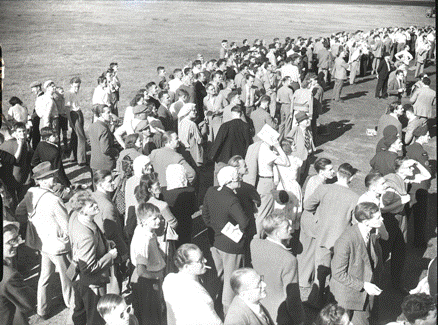 |
|---|
©Flight CollectionSpectator numbers swelled during the 1950s |
As with all events staging demonstrations of an aircraft's full potential, Farnborough has seen its share of accidents following mishandling or airframe failure. The most horrific occurred on the Saturday in 1952: a de Havilland 110 broke up in the air, killing both crew members and 28 spectators, and injuring many more. The display continued, with Neville Duke taking off from the wreckage-strewn runway to provide supersonic booms in the Hunter. Air-traffic control asked him to "soft-pedal" his display over the crowd.
Another 1952 highlight was "Roly" Falk flying solo in the Avro Vulcan three days after its first flight. Appearing for the first time were the Bristol Britannia turboprop airliner and the big Gloster Javelin all-weather fighter.
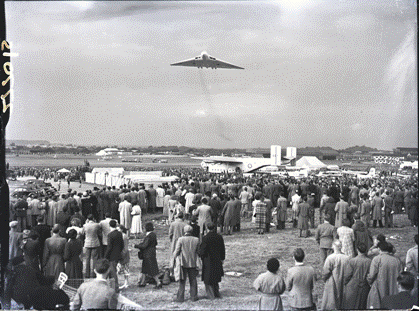 |
|---|
©Flight CollectionThe Avro Vulcan was a highlight in 1952 |
Flying at the 1952 and 1953 shows was the huge Saunders-Roe Princess flying-boat, powered by 10 engines (but, like the Brabazon, destined never to enter service). The 1953 display saw the first collective presence of Britain's three V-bombers - the Valiant and Vulcan joined by the new Handley Page Victor.
The exhibition moved again in 1954, this time to the high ground that remains its home. Exhibitors numbered more than 300 by 1955, when the first truly supersonic British aircraft, the English Electric P.1 (predecessor of the Lightning) appeared. The display included a climbing roll by the Vulcan, a 12-strong Valiant flypast, and 64 Hunters.
The Fairey FD2 research aircraft was the star in 1956, having that year set the first 1,000mph (1,600km/h) world air-speed record. Farnborough's famous blue-and-white canvas chalets were introduced as the organiser created four permanent terraces for exhibitors' hospitality - a valuable development given that year's heavy rain.
Last manned fighter
Almost 100 service aircraft took part in 1957, just a few months after the Conservative government concluded the Lightning interceptor should be the RAF's last manned fighter: the future lay in guided missiles.
Despite this policy, the Blackburn NA39 naval bomber (forerunner of the Buccaneer) made its debut in 1958, as did the Fairey Rotodyne vertical take-off/landing airliner. A display highlight was a 22-Hunter formation loop, and there were flypasts by 45 Hunters and 45 Javelins. R&D was illustrated in 1959 by the appearance of the Short SC1 VTOL testbed and Saunders-Roe SRN1 hovercraft.
The SBAC entered the 1960s with a revolutionary idea: it admitted overseas manufacturers, provided they made aero engines that powered British aircraft. Previous participant de Havilland Aircraft of Canada's products were deemed to be British, courtesy of their Hatfield heritage. So popular was the show that nearby RAF Odiham accommodated nearly 200 military aircraft, bringing in more than 1,700 overseas guests.
The 1960 display opened with a daily "scramble" of four V-bombers, with Valiants, Victors and Vulcans simulating retaliatory strikes against an assumed communist aggressor. The reaction of Soviet engineers Oleg Antonov and Aleksandir Yakovlev, both present at the show, is not recorded.
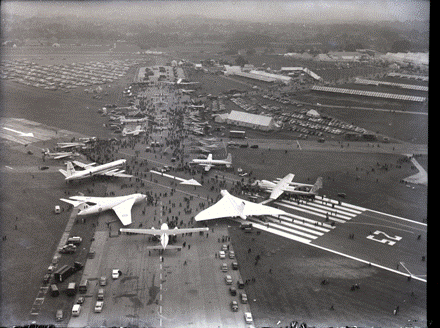 |
|---|
©Flight CollectionThe RAF's V-bombers (Victor and Vulcan pictured) were stars of the 1960 show |
That year saw the final display by the RAF Black Arrows formation team in their Hunters. A 1960 participant destined to replace them was the Folland Gnat trainer, which reappeared in 1964 as the mount of the Yellowjacks and then, until 1978, of the Red Arrows.
Seen for the first time was the British Executive and General Aviation (Beagle) pack, which incorporated former Auster and Miles designs. The kennels at Rearsby and Shoreham disgorged the Airedale, Husky and Terrier light aircraft, the organiser not applying its otherwise strict "no dogs" regulation.
The Handley Page HP115, built to explore low-speed handling of narrow delta wings, represented R&D work. R-R showed its new Conway bypass engine as assorted teams of Fairey Gannets, Hunters, Lightnings, Supermarine Scimitars, Sea Vixens, Saunders-Roe Skeeters, and (on public days) Druine Turbulents vied for spectators' attention.
In 1961, participation of nearly 150 aircraft from the armed services bolstered the few new aircraft in the flying displays, although nearly 400 companies occupied 12,100m2 (130,250ft2) of exhibition space.
With the UK industry entering a period of severe consolidation and few new products appearing, the SBAC announced in 1962 that there would be no 1963 Farnborough show and the 1964 event would include British or British-made products only.
Debutants in 1962 included the de Havilland DH121 Trident and Vickers VC10 jetliners, DH125 business jet, and the much smaller Wallis Autogyro. The Bristol T188 high-speed research aircraft and the VTOL Hawker P1127 represented development programmes.
Biennial frequency
In 1964, the SBAC became the Society of British Aerospace Companies, but did not immediately confirm the biennial frequency that would see Farnborough alternate with the Paris air show. In an unfortunate choice of words, Flight International showed, in its Farnborough special issue, the consolidated UK industry "quite literally at a glance".
New aircraft included the short-lived Beagle B242, British Aircraft Corporation One-Eleven "bus-stop" jetliner and ogival-winged BAC 221 research aircraft, and the diminutive Short Skyvan turboprop and much-larger Belfast military transport.
The SBAC produced its first public-day souvenir programme and introduced vintage aircraft, perhaps having subsequent doubts after the Bristol Bulldog stalled and crashed.
By Farnborough 1966, the SBAC took a less parochial view and permitted the display of European aircraft, provided they had British engines or substantial other UK content. The Red Arrows made their show debut, as did the twin-engine Britten-Norman Islander.
Westland showed the Scout, Sioux, Wasp, Wessex 2 and 5, and Whirlwind helicopters, but was eclipsed by Hawker Siddeley's collection, including the Andover, Buccaneer, Dominie, Gnat trainer, HS125, HS748, Hunter, Kestrel, P1127, Shackleton, Trident and Vulcan. Europeans included the Aermacchi MB326 trainer, Breguet Atlantique maritime-reconnaissance aircraft, Fiat G91 lightweight fighter, Fokker F27 Friendship regional turboprop, and Transall 160 military transport.
Anticipating the regional-airline revolution, the Handley Page Jetstream feeder-liner appeared at Farnborough in 1968, with the new Hawker Siddeley Harrier and McDonnell F-4K Phantom - the latter two ironically owing their existence to Labour government defence cuts. Having appeared from 1949-61, the Comet returned in Nimrod MR1 reconnaissance guise in 1968 - and, in MRA4 form, might fly at Farnborough in 2010.
The show was held slightly later in 1968, when late-summer rain left parts of the airfield under water, with the first day's flying cancelled. Machines such as the Sud SA330 and SA341 helicopters, allowed to take part by dint of having significant UK equipment content, could land away from the puddles.
Apart from the miserable weather, the 1968 show is remembered for the loss of the Breguet Atlantique, which stalled during recovery from a single-engine flypast, killing the crew and one person on the ground.
With international collaboration de-rigueur industrial policy, two Anglo-French projects - the Sepecat Jaguar fighter-bomber and BAC/Sud Concorde supersonic transport - appeared at Farnborough 1970. Other international participants were the MB326 trainer and Ling-Temco-Vought Corsair II.
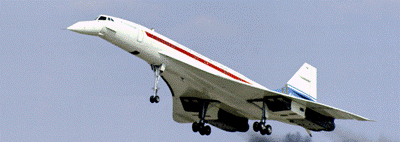 |
|---|
©Flight CollectionConcorde made the first of many Farnborough appearances in 1970 |
Britten-Norman's three-engine Trislander feeder-liner arrived on the day of its maiden flight, while the Canberra bomber made its last appearance after 21 years. The show was marred by the Wallis Autogyro accident, in which test pilot "Pee Wee" Judge was killed.
Now "Farnborough Europe", the 1972 event featured three military aerobatic teams: Britain's Red Arrows, France's Patrouille de France and Italy's Frecce Tricolori. About 10% of the 250 exhibitors were from overseas, and exhibition space was almost 13,000m2.
Sweden's Saab Viggen fighter made the first of many appearances, but its smaller Saab 105 sibling departed with a red face after a wheels-up landing. Hindustan Aircraft showed its version of the Folland Gnat fighter, but overshadowing everything was the R-R RB211-powered Lockheed TriStar.
In 1974, the SBAC bit the bullet and established Farnborough as a truly global eight-day event. Almost half the 380 exhibitors were from overseas and a second exhibition area nearly doubled covered space to 22,800m2.
US attendees included the transatlantic-record-setting Lockheed SR-71A and McDonnell Douglas TF-15A Eagle, while new multinational products were the Airbus A300B2, the world's first twin-aisle twin-jetliner, and Dassault-Breguet/Dornier Alpha Jet trainer.
The UK provided the Hawker P.1182 (later Hawk) trainer. Again, the show was marred when the Sikorsky S-67 Blackhawk crashed fatally after failing to complete an aerobatic manoeuvre.
The variable-geometry Anglo-German-Italian Panavia Tornado arrived in 1976, when the (also variable-geometry) Grumman F-14 Tomcat and McDonnell Douglas YC-15 military transport made their sole Farnborough appearances. French test pilot Pierre Baud flew the show's largest and smallest jets - the Airbus A300 and Bede BD5J.
Ski-jump demonstration
Farnborough continued to grow, with new chalets in 1978 taking the total to more than 200 units. Notable was the BAe Harrier "ski-jump" demonstration from a purpose-built ramp and the appearance of the 50-seat de Havilland Canada Dash 7 regional airliner and Cranfield A1 aerobatic aircraft.
An original British design in 1980 was the Edgley Optica observation aircraft. Other general aviation designs included the Socata Tampico, heralding a new range of French light aircraft. France also showed Dassault-Breguet's Mirage 4000, which competed in the loudest noise/tightest-turn stakes against the General Dynamics F-16B, McDonnell Douglas TF-18A, F-15B and Tornado F2. The Canadair Challenger was another debutant.
Landscaping of the show's exhibition area permitted westward extension of the four main chalet lines, and enlargement of the South Hall to give total space of 16,350m2.
Celebrating 50 years since that first SBAC show at Hendon, the 1982 event saw 480 exhibitors in the New North Hall on the site of the radar terrace, which was now behind hospitality chalets. The Airbus A310, which was in flight test, went head-to-head with rivals from across the Atlantic, the Boeing 757 and 767 twinjets. A new British aircraft was the Slingsby T67, derived from a Rene Fournier design.
Of 79 aircraft flying in the 1984 show, more than 20 were making their maiden appearance, with 14 debutants in the static display. The event saw the first presentation of Russian aircraft: the Antonov An-72, Ilyushin Il-86 and Mil Mi-26. The de Havilland Dash 8, Embraer Brasilia and Saab 340 illustrated the competition for regional airliner sales.
Many remember Bill Loverseed's spot-landing in the de Havilland Buffalo after a strong tailwind reduced elevator effectiveness. The crew climbed out of the wingless wreckage.
Two new chalet lines in 1986 took the total to almost 300. Rearrangement of other facilities permitted construction of a fourth exhibition space, the New South Hall, pushing the total area to 42,700m2. There were 140 static-display aircraft, including the Antonov An-124, the world's heaviest aircraft.
New aircraft flying in 1986 included the Airbus A300 "fly-by-wire" demonstrator, BAe's EAP single-seater research aircraft, ATP, and Harrier GR5, Boeing E-3A Sentry, Dassault-Breguet Rafale, Fokker 50, and Sikorsky S-70. On the ground were an Aero Spacelines "Super Guppy" transporter and 13 military trainers.
A 1988 highlight was the first Western display appearance of the MiG-29, including a dramatic tail-slide. But Soviet participation was offset by, first, an An-124 engine failure and then a runway departure by an An-22 bringing replacement engine parts. When the MiG-29 did not fly later in the week, the flying control committee grounded the pilot.
A new powerplant concept demonstrated at Farnborough was General Electric's ultra-high bypass unducted fan on a McDonnell Douglas MD-80 testbed.
The Optica was joined in 1988 by other ill-starred British light aircraft: the Orca/Trago Mills SAH-1, Island Aviation/ARV Super 2 and the Norman Fieldmaster, Freelance and Turbo Firecracker. More site development added two-storey chalets and exhibition areas renamed Halls 1 to 5.
World's largest
In 1990 came the world's largest aircraft, the Antonov An-225, and more than 30 countries were represented at the 1992 event, which included first appearances by 15 aircraft from former Soviet states, as well as the Airbus A340 quad-jetliner and Saab Gripen.
In 1994 two DC-3/C-47s sported rival Pratt & Whitney Canada PT6A turboprop conversions. The Sukhoi Su-35 made its first appearance.
What the SBAC dubbed "considerably improved modern halls and chalets" greeted 1,150 exhibitors in 1996, as 130,000 trade visitors perused 130 aircraft.
A Northrop B-2A put in a fleeting appearance. The 50th show, in 1998, saw debuts for the Lockheed Martin C-130J Hercules and Airbus A330, and in 2000 the NH90 helicopter was a first-timer.
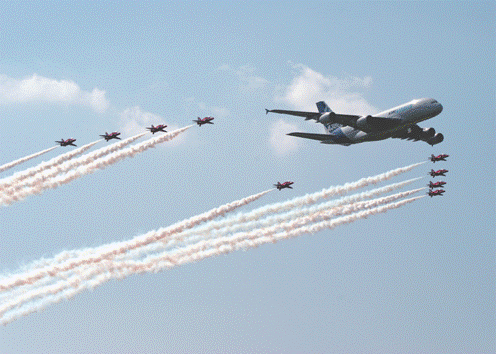 |
|---|
©Max Kingsley Jones/Flight InternationalThe Airbus A380 - and the Red Arows - starred at the show two years ago |
The new millennium saw a radical change - of date, to July, midway in the biennial cycle of global shows, Paris being on alternate years. SBAC said: "We've moved into the sun."
Innovations in 2004 were the Motorsport Valley Pavilion, to demonstrate synergy between that industry and aerospace, the International Space Pavilion, and a dedicated business aircraft park. The show also saw the first appearance of a Boeing 747.
Three years ago, the SBAC transferred its exhibitions "assets" to Farnborough International, which runs the show and is charged with developing further events and services, beginning in 2006 with a shortened "industry day", conferences and a dinner.
The 2006 show attracted 140,000 trade visitors and almost 1,500 exhibitors. It starred the Airbus A380, of which at least one example has been ordered for VIP use. Its internal appointments as a "flying palace" certainly beat those offered on the Short Solent flying-boat at the first Farnborough 60 years ago.
Source: Flight International



















